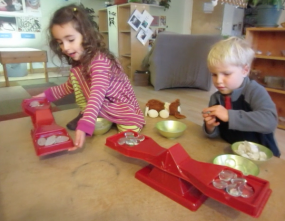Balance Scale

Charlie and Lettie, three-years-old, add pebbles to a balance scale. After adding a similar pebble to each side of the scale, Charlie exclaims, “It’s even. These guys are even” (00:19). What do you think Charlie assumes is even? Is he referring to the number of pebbles, one per side? Does he mean the arms of the scale are even (parallel) with the tabletop? Notice Charlie does not drop the pebbles onto the scale; he gently places them. His measured actions suggest that Charlie may sense that the weight of the pebbles will counter each other, thereby causing the scale to return to equilibrium. Repeatedly, Charlie adds one pebble to each side and announces, “It’s even.” Lettie has a different goal for her play with the scale. She explains, “I’m trying to make it go up and down” (01:33). Lettie works by adding several pebbles to one side of the scale before adding several pebbles to the other side. Likely influenced by Charlie’s restated goal, Lettie supports the scale with her hands and says, “Mine’s even…Look what I made” (02:07). Around the same time, Charlie encounters a problem. His scale becomes unbalanced (01:55). By working successfully to make it “even” (restore equilibrium), Charlie shows he understands that the weight of the pebbles on one side counteract the effect of the weight of the pebbles on the other side of the scale (02:02 – 03:20). Notably, Charlie reveals his expectations by wondering aloud as he works to add pebbles to the side that has tipped. He says, “I wonder when it’s going to move?” (03:01). Once he achieves balance again, he exclaims, “Ah-hah! Now it’s even! Now the arrow is pointing down.”
Keywords: threes, child-object, math, science, weight, interacting forces
Length of video: 3 minutes 24 seconds
